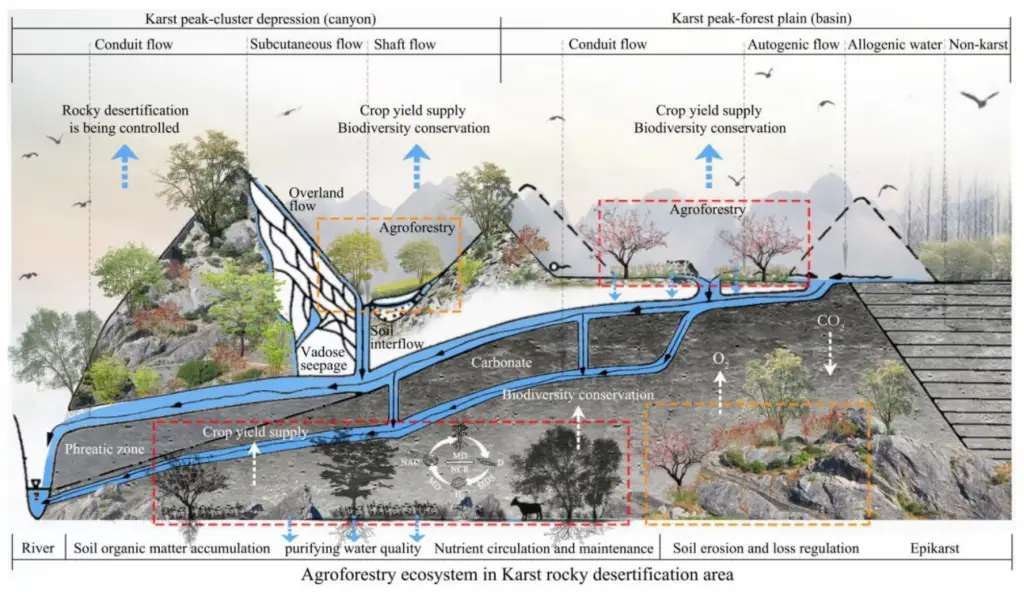One of the most common problems with trees is that their roots can spread out and damage sidewalks, patios, and even the foundation of your house. There are several things you can do to prevent this from happening.
- If a tree’s roots are causing problems, the first step is to determine why the roots are spreading
- Common causes of root spread include poor drainage, soil compaction, and damage to the root system
- To prevent root spread, improve drainage around the tree and avoid damaging the roots
- If the tree is already suffering from root spread, try to correct the problem with deep watering and mulching
To prevent this from happening, there are several effective methods you can employ. This in-depth guide will provide you with the necessary steps to prevent tree roots from spreading.
- Identify the Cause of Root Spread:
The first step in preventing root spread is to determine the underlying cause. Common reasons for root spread include poor drainage, soil compaction, and damage to the root system. By understanding the cause, you can address the specific problem more effectively. - Improve Drainage:
To prevent root spread caused by poor drainage, ensure that the area around the tree has proper drainage. This can be achieved by creating channels or installing drainage pipes to redirect excess water away from the tree’s root zone. - Avoid Damaging the Roots:
Take precautions to avoid damaging the tree’s roots, as this can trigger root spread. When performing any landscaping or construction work near the tree, be mindful of the root system and take necessary measures to protect it. Avoid digging too close to the tree or using heavy machinery that could harm the roots. - Correct Root Spread Issues:
If the tree is already experiencing root spread, there are steps you can take to address the problem. Deep watering can encourage the roots to grow deeper rather than spreading horizontally. Apply mulch around the base of the tree to retain moisture and provide insulation for the roots. - Implement Tree Root Barriers:
Tree root barriers can be highly effective in preventing root spread. There are different types of barriers you can use:
- Impenetrable Material: Use materials such as concrete, asphalt, or metal to create a physical barrier that prevents the roots from growing beyond a certain point. This method is commonly used for sidewalks, patios, and foundations.
- Physical Barriers: Install fencing or landscaping fabric around the base of the tree to contain the roots within a specific area. This method is effective for preventing root spread into lawns or other parts of the garden.
- Chemical Barriers: Chemical barriers, such as herbicides or root barriers, can be used to kill or inhibit the growth of tree roots. However, caution must be exercised when using chemicals, as they can have environmental implications and may harm other plants in the vicinity.
- Maintain Tree Health:
Keeping the tree healthy and strong is crucial in preventing invasive root growth. Regularly water the tree, especially during dry periods, to ensure it receives adequate moisture. Fertilize the soil around the tree to provide necessary nutrients, and prune the tree to maintain its overall health and shape.
By following these steps, you can effectively prevent tree roots from spreading and minimize the potential damage they may cause. Remember to assess the specific needs of your tree and consider the environmental implications of your chosen methods.
What Can I Use As a Tree Root Barrier?
There are a few different ways that you can use to create a tree root barrier. One way is to use an impenetrable material, such as concrete, asphalt or metal, to block the roots from growing. Another way is to use a physical barrier, such as fencing or landscaping fabric, to keep the roots contained.
You can also chemical barriers, which work by killing the tree roots that come in contact with it.
How Do You Prevent Invasive Roots?
There are a few things you can do to prevent invasive roots. One is to keep the tree healthy and strong so that its roots don’t feel the need to search for food and water elsewhere. This means regular watering, fertilizing, and pruning.
You can also install a physical barrier around the tree, like a wire fence or concrete wall. This will physically stop the roots from spreading into other areas. Finally, you can use chemicals like herbicides or root barriers to kill or stop the growth of roots.
Does Cutting Tree Stop Roots Growing?
No, cutting a tree does not stop the roots from growing. The roots continue to grow and expand even after the tree has been cut down. This can cause problems for adjacent trees and buildings, as the roots can damage them.
How Do You Keep Tree Roots from Coming to the Surface?
One of the best ways to keep tree roots from coming to the surface is by regularly watering and fertilizing your trees. If you water and fertilize your trees on a regular basis, their roots will be less likely to come to the surface in search of moisture or nutrients. Additionally, you can mulch around your trees to help keep their roots cool and moist.
Installing Root Barriers to Protect House Foundations and Sidewalks
How to Stop Tree Roots from Growing under House
When it comes to trees and your home, the roots always seem to find a way to grow under your house. This can cause all sorts of problems, from cracked foundations to lifted sidewalks. But there are ways that you can stop tree roots from growing under your house and causing damage.
One way is to install a root barrier. This is a physical barrier that goes around the perimeter of your house and prevents tree roots from growing towards it. Root barriers can be made from a variety of materials, including concrete, metal, plastic, or even fabric.
Another way to stop tree roots from growing under your house is to keep them trimmed back. If you have trees in your yard, make sure to regularly trim their roots so they don’t have a chance to grow towards your home. You can do this yourself with a shovel or hire a professional tree service to do it for you.
Finally, you can also try chemicals as a last resort. There are products on the market designed specifically for killing tree roots. However, these should only be used as a last resort as they can potentially harm other plants and animals in your yard if used improperly.
Root Barriers for Trees
When planting trees, it is important to consider the long-term effects of their roots. As trees grow, their roots spread outwards in search of water and nutrients. If left unchecked, tree roots can cause serious damage to buildings, sidewalks, and other infrastructure.
Root barriers are installed in order to prevent this damage from occurring. Root barriers are typically made from concrete, metal, or plastic. They are placed around the perimeter of a tree’s root zone in order to prevent the roots from spreading beyond that point.
Root barriers can be effective at preventing damage to nearby structures, but they must be properly installed and maintained in order to be effective. If you are considering installing a root barrier for a tree on your property, it is important to consult with an arborist or other tree care expert first. They will be able to assess the needs of your specific tree and recommend the best type of root barrier for your situation.
Here’s a table summarizing the pros and cons of using physical barriers to prevent tree roots from spreading:
| Pros | Cons |
|---|---|
| Durability: Physical barriers made of materials like wire fences or concrete walls are known for their durability. They can withstand the pressure exerted by tree roots and provide long-lasting protection. | Limited Effectiveness: While physical barriers can be effective in preventing root spread in the immediate vicinity, they may not completely stop root growth. Tree roots can sometimes find small openings or gaps in the barriers and continue to grow beyond them. |
| Visual Appeal: Depending on the design and material chosen, physical barriers can enhance the aesthetic appeal of the surrounding area. They can be incorporated into the landscape design, adding a decorative element. | Potential Damage: Improper installation or maintenance of physical barriers can cause damage to the tree or surrounding structures. For example, if a concrete wall is built too close to the tree trunk, it can lead to root girdling, which can harm the tree’s health. |
| Ease of Installation: Physical barriers are relatively easy to install, especially wire fences. They can be installed by homeowners or professionals without requiring specialized skills or equipment. | Cost: Depending on the size of the area to be protected and the materials used, physical barriers can be costly. Concrete walls, for instance, require more investment compared to wire fences. |
Using physical barriers like wire fences or concrete walls can be an effective method to prevent tree roots from spreading. Here are the pros and cons of using physical barriers:
These are the key advantages and disadvantages of using physical barriers to manage tree root spread.
When considering the use of chemicals like herbicides or root barriers, it is important to be aware of the potential risks and considerations:
Risks:
- Environmental Impact: Chemicals used for root control can have negative effects on the environment, especially if not used properly. They may contaminate soil, water sources, or harm other plants and organisms in the vicinity.
- Health Concerns: Some herbicides and root barriers may pose health risks to humans and animals if not handled or applied correctly. It is important to follow safety guidelines and use protective gear when working with these chemicals.
Considerations:
- Selectivity: Different chemicals have varying levels of selectivity, meaning they may target only specific types of plants or have a broader impact. Consider using selective herbicides to minimize harm to non-target plants.
- Application Timing: Timing is crucial when using chemicals. Applying herbicides or root barriers at the wrong time may not be effective or could harm the tree itself. Follow instructions carefully and consult with professionals if needed.
- Long-term Monitoring: Chemical treatments may require regular monitoring to ensure their effectiveness. Monitoring root growth and reapplication of chemicals may be necessary to maintain the desired results.
It is always recommended to consult with professionals, such as arborists or tree care experts, to assess the specific needs of your tree and to determine the most appropriate method for preventing root spread.
How to Stop Tree Roots from Growing in Lawn
Have you ever noticed tree roots growing in your lawn and wondered how to stop them? Well, there are a few things you can do to prevent this from happening. First, make sure that you regularly trim the trees in your yard.
This will help to keep the roots from getting too long and causing problems. Secondly, you can use a root barrier around the base of the tree. This will help to keep the roots contained and away from your lawn.
Finally, if you have a particularly large tree, you may need to hire a professional to come and remove some of the roots.
Does Trimming Trees Prevent Root Growth
Most people believe that if you cut the branches off a tree, it will prevent the roots from growing. However, this is not always the case. If the roots are already established and strong, they may continue to grow despite the removal of branches.
In some cases, trimming trees can actually promote root growth by stimulating new growth from the stump or base of the tree.
Conclusion
One of the best ways to prevent tree roots from spreading is by using a root barrier. A root barrier is a physical barrier that helps to keep tree roots contained. There are many different types of root barriers available on the market, so it is important to choose one that is appropriate for your tree and your soil type.
Another way to prevent tree roots from spreading is by regularly trimming them. This will help to keep them under control and stop them from growing into areas where they are not wanted.


 Dr Ahsanur Rahman, PHD
Dr Ahsanur Rahman, PHD



